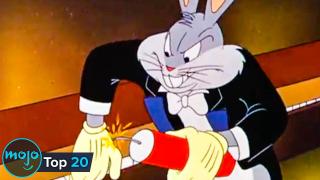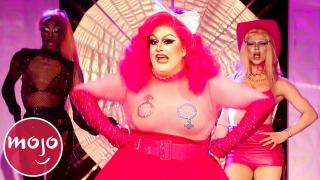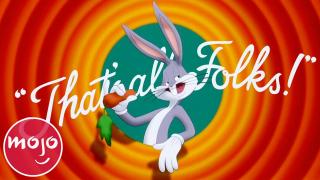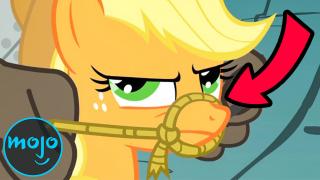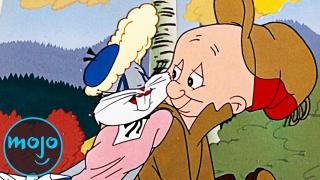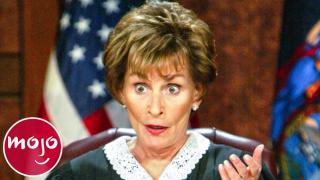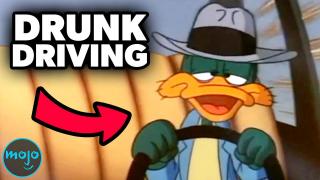Top 10 Most Disturbing Looney Tunes Facts
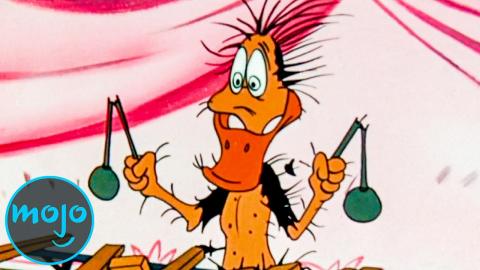
#10: Too Risqué For Kids
Top 10 Most Iconic Looney Tunes Catchphrases
The original batch of “Looney Tunes” cartoons were made between 1930 to 1969. Although the shorts were frequently shown to kids before movies in theaters, some of the humor would go over their heads. Standards were different for TV broadcasts. When “Looney Tunes” began airing on television, the shorts would often be reedited because of their content. Adult humor, dark jokes, and things no longer considered politically correct were often censored or omitted entirely. Although uncensored versions can be found more readily these days online and on dvds, it’s disturbing to realize that the cartoons we grew up with may not have been the originals.
#9: Bugs Changed a Word’s Meaning
Top 20 Worst Things Bugs Bunny Has Done
One of Bugs Bunny’s most frequent nemeses is the buffoonish hunter, Elmer Fudd. The wisecracking wabbit is prone to lobbying insults like nimrod at the hapless hunter. However, the term may not mean what you think…or at least, it didn’t before Bugs got a hold of it. In the Bible, Nimrod was the grandson of Noah and was renowned as a great hunter. Bugs referring to Elmer as nimrod was sly sarcasm. However, viewers unfamiliar with Nimrod’s Biblical origins began using the word as an insult, likening a “nimrod” to a slow, dim-witted person like Elmer Fudd. It’s quite the legacy!
#8: Original Tweety
Top 10 RuPaul's Drag Race Original Songs
Tweety Bird is the sweet, yellow bird who is often paired with Sylvester the Cat in their cartoons. However, before he “tawt he saw that puddy tat,” Tweety’s original look was very different. Tweety first debuted in the short “A Tale of Two Kitties” opposite two cats inspired by Abbott and Costello’s personalities. During this short, we were introduced to the little bird’s signature catchphrase and familiar voice. However, everything else about him was slightly different. Tweety lacked any feathers and his name was...Orson? We can see why Warner Bros elected for his more colorful appearance and memorable name down the line.
#7: “Looney Tunes,” Not “Toons”
Top 10 Hilarious Looney Tunes Running Gags
“Looney Tunes” has been around for 90 years now. So, you’d think everyone would be familiar with its name and how to spell it, right? Well, think again! People think that the “Tunes” part of the title should be spelled like the “toon” in the word “cartoon.” Given that the words are homophones and “Looney Tunes” are synonymous with cartoons, it’s an easy mistake to make. However, there are those who believe that this spelling snafu is an example of the Mandela Effect, a phenomenon of collective false memory where some believe reality has been altered at some point. We’d be curious what believers have to say about the spelling of “Looney Tunes”’ musically-named sister series, “Merrie Melodies,” as well as Disney’s “Silly Symphony.”
#6: Mostly Male
10 Dark Facts About My Little Pony That Will Ruin Your Childhood
While this may not exactly come as a surprise, it can be easy to forget that the vast majority of classic “Looney Tunes” characters are male. There are a few exceptions. Early cartoons featured Granny who owns Tweety, and Penelope Pussycat, the frequent object of Pepe Le Pew’s unwanted affections. But both are comparatively minor characters. It’s only in recent spin-offs such as “Space Jam” or “Tiny Toon Adventures” that female characters began to gain more of a presence. The classic “Looney Tunes” shorts will always have their charm. But once you notice the lack of female characters, you might not look at them the same way again.
#5: One Beer “Tiny Toon Adventures” (1990-92)
Top 10 Things Only Adults Notice in Looney Tunes
Since “Tiny Toon Adventures” is a “Looney Tunes” spin-off, we’re counting it! We’ve already mentioned that the franchise has had problems with censorship.“Tiny Toons” was no exception. One of its banned episodes was called “Elephant Issues,” and featured an infamous segment called “One Beer.” It was a “very special” segment meant to warn kids away from the dangers of drinking. Mixing that kind of thing with cartoons is always a dicey business. And it doesn’t help that it’s been rumored that the show’s staff didn’t like writing “very special” episodes. How did this one go wrong? Well, three young toons drink a beer, drive off a cliff, and die! They reveal they’re alright in the end, but that’s still really dark!
#4: Porky’s Stutter
Porky Pig is the lovable, mild-mannered character that often closes out “Looney Tunes” shorts. He also acts as the straight man to characters like Daffy Duck. But Porky’s most famous feature is his noticeable stutter. What you may not know is that the stutter wasn’t just a character affectation! Joe Dougherty, the first voice actor to play the pig, had a stutter in real life and brought that to the character. Unfortunately for Dougherty, he couldn’t control his stutter, which resulted in his recording sessions lasting hours and becoming more expensive. The rising cost led him to be replaced by the more familiar Mel Blanc, who was able to stutter on cue.
#3: Speedy Gonzales Controversy
When Cartoon Network gained the rights to air Speedy Gonzales cartoons, they decided against including his shorts in their programming. While the company said that his cartoons didn’t do well in the ratings, they also had concerns the character may be culturally insensitive. There’s no denying that Speedy’s original, gold-toothed design was ridiculously offensive. And his cousin, Slowpoke Rodriguez, could also be perceived as promoting stereotypes. However, fans from the Hispanic community voiced their support for Speedy when they found out his shorts would largely be absent from Cartoon Network. Fortunately, fans of this fast mouse saw his cartoons race back onto network programming in 2002.
#2: Things That Take Your Life
Top 10 Things You Didn’t Know About Judge Judy
It’s no secret that “Looney Tunes” features a lot of cartoon violence. Some of that mayhem involved firearms. Still, it can get darker than a lot of people remember. During some cartoons, the characters either threaten to or actually end it all with a dangerous weapon. Bugs and Yosemite Sam play Russian Roulette in one short. Daffy even blasts himself as part of a gag! If you’re into dark humor, these still may be pretty funny to you. But we definitely understand why the prospect of showing these shorts to children is tricky. Many of these macabre cartoons ended up being censored for years.
#1: Censored Eleven
Top 10 TV Shows That Had to be Censored
Although we’ve discussed the occasional edited moment already, the Censored Eleven are a different animal altogether. These eleven “Looney Tunes” and “Merrie Melodies” shorts feature racial and ethnic stereotypes. While they’re not the only Warner Bros cartoons to make use of politically incorrect depictions, these shorts made offensive representations essential to their plots. Since executives couldn’t avoid the fact that these cartoons were intrinsically linked to stereotypes and racist caricatures, they were pulled from broadcast in 1968. None of these shorts have been shown officially on TV since then. But there are still traces of them across the internet and old video formats. These cartoons stand as reminders of an offensive chapter in “Looney Tunes” history.


